
Magento 2 Customer Segments: 8 Rules for Customer Segmentation
Want to boost conversions and improve customer satisfaction? Magento 2 Customer Segments lets you group customers by specific attributes and conditions. It helps to create targeted marketing campaigns utilized to the needs and interests.
This article will cover how customer segments can boost ecommerce customer segmentation strategies.
Key Takeaways
-
What Magento 2 customer segments are and how do they work?
-
Key features that improve customer segmentation in Magento.
-
Rules for setting up precise customer segment extensions.
-
Top best customer segments plugins and extensions.
-
Tips for better customer segmentation in ecommerce.
-
Solutions for common issues with Magento customer segments.
What are Magento 2 Customer Segments?
Magento 2 customer segments allow businesses to group customers based on different attributes. It helps in creating targeted campaigns.
Magento 2 customer segments work with both Magento Open Source and Adobe Commerce. It allows to categorization of customers by specific attributes like:
-
Demographics
-
Behavior
-
Preferences
Segmentation makes it easier to create marketing campaigns used to match a customer need. It is based on miscellaneous customer information for ecommerce. Merchants can personalize the shopping experience in Magento 2. It leads to precise targeting and accurate Magento customer segmentation.
Classification of Custom Segmentation in Magento 2
1. Demographic Segmentation
Demographic segmentation divides customers by traits. It includes gender, age, marital status, education, occupation, income, and location.
-
Age: Segment customers by age to understand their budgets and product preferences.
-
Gender: Include all genders to create segments that cater to diverse groups.
-
Marital Status: Group customers as “married,” “in a relationship,” or “single” using rules.
-
Occupation: Segment by occupation to learn about income, budgets, and interests. It helps customers through personalized marketing.
2. Behavioral Segmentation
Behavioral segmentation focuses on customer purchase history, marketing responses, and usage patterns.
-
Frequency of Purchases: Identify frequent buyers and reward them with targeted offers.
-
Ecommerce Activity: Track order status added to carts or wish lists. The segments are based on purchases or abandoned cart items.
-
Website Activity: Monitor customer actions on the site and segment. It includes special features that let the customer to match their interests.
-
Recent Engagement: Respond to recent customer interactions with special promotions.
3. Geographic Segmentation
Geographic segmentation organizes customers by location, using their address details in Magento 2.
-
Preferred Language: Create segments based on preferred languages to improve communication.
-
Location: Adjust marketing based on customer location, whether city, neighborhood, or region.
-
Transportation: Segment conditions for the customer to commute to target ads better.
4. Psychographic Segmentation
Psychographic segmentation groups use customers by interests, values, and personality traits.
-
Interests: Target ads based on hobbies or interests, like sports or pets.
-
Values: Use surveys to learn customer values. Create segments that match, enhancing product offerings.
-
Personality Traits: Group by personality traits to create marketing. It resonates with each customer segment.
5. Needs-Based Segmentation
Needs-based segmentation sorts customers by specific product or service needs.
-
Service Needs: Group customers by how they prefer to interact with the service. It includes support or delivery.
-
Product Features: Segment based on the product features customers value most.
-
Preferred Delivery Method: Group customers by preferred delivery options. It can meet their shipping needs.
6. Technographic Segmentation
Technographic segmentation divides customers by the devices, applications, and software they use.
-
Browser Type: Group customers by the browsers they use, like Chrome or Firefox. It can optimize the Magento site accordingly.
-
Device Type: Segment customers who used custom affiliate device types, whether mobile or desktop. It utilized the Magento user experience.
-
Original Source: Segment by how customers find the business. It includes social media or search engine rankings to refine the marketing.
6 Key Features of Magento Customer Segments
1. Rule-Based Customer Categorization
The Magento 2 customer segmentation extension lets users create unlimited customer segments. Using various customer information, it includes simple and customizable rules. Users can group both registered and guest customers. It is based on different customer attributes and conditions. Specific customer segments help users create utilized marketing strategies for each customer group.
2. Enhanced Cart Price Rules Integration
Magento 2 customer segments can be easily integrated into Cart Price Rules. It allows to creation of targeted campaigns for specific customer. The extension offers personalized deals. It includes customer groups that are currently in the Magento shopping cart or wish list. Its integration helps focus the marketing efforts for better results.
3. Exportable Segmentation Lists
Magento customer segmentation extension makes it simple to export segmentation lists. Customers can export data in CSV or XML formats. It makes it easy to manage and analyze customer information. Customer segments help refine the marketing strategies and target the right customer groups.
4. Segment Performance Tracking
With Magento 2’s customer segmentation extension, users can track their performance. Each customer segment can be tracked through detailed reports. The reports show the number of customers and orders in each segment. It helps customers identify high-value customer groups. The data allow users to create more effective, targeted marketing campaigns.
5. Visual Data Representation
The Magento 2 segmentation module offers visual data representation with four chart types:
-
Area
-
Line
-
Bar
-
Pie
The charts help see customer and order data across different segments. It makes customers understand segment performance at a glance. The segments help to spot trends and make better decisions for customer targeting.
6. Multi-Store and Multi-Language Support
The customer segmentation extension supports multi-store and multi-language setups. It makes it easy to manage and create a customer segment across different store views. Magento 2 has multiple storefronts and operates in different regions. It includes the customer information is available for the Magento stores. The extension does not matter where the customers are.
Understanding Customer Segments Extension Rules
-
Customer Attribute Segmentation: It is powered by Magento. The extension allows for better organization of the customer base into specific groups. Group customers by attributes like age, location, or purchase history. It makes it easier to create targeted segments that align with the marketing goals.
-
Registered and Guest Grouping: Guest customers into relevant groups using the segments included. It helps ensure that the marketing reaches all types of customers in the Magento 2 website store.
-
Simple Segmentation Rules: Set simple rules for segmenting customers. It is based on factors like cart contents, location, or order history. The rules help the customers to create accurate customer segments for better targeting.
-
Flexible Grouping Rules: Use adjustable rules to organize customers into segments. It can fit Magento's marketing needs. The flexibility makes it easy to adapt as your customer base or goals change.
-
Extension Compatibility: The segmentation extension works well with Magento. The compatibility lets customers use advanced segmentation options to improve marketing.
-
Error Handling in Indexing: The customer extension handles errors during segment indexing. This is especially true when addresses are missing. It ensures that all relevant customers are included, even if some data is incomplete.
-
Location-Based Campaigns: Create campaigns based on customer location. Their shipping or billing addresses use it. The feature helps utilize Magento special promotions to specific regions for better results.
-
Segment Export and Management: Easily export customer segmentation lists. It includes different formats for analysis or use in other Magento 2 systems. The extension also allows re-indexing segments, keeping the data current.
Top 5 Customer Segments Plugins and Extension for Magento 2
1. Customer Segmentation for Magento 2 by Amasty
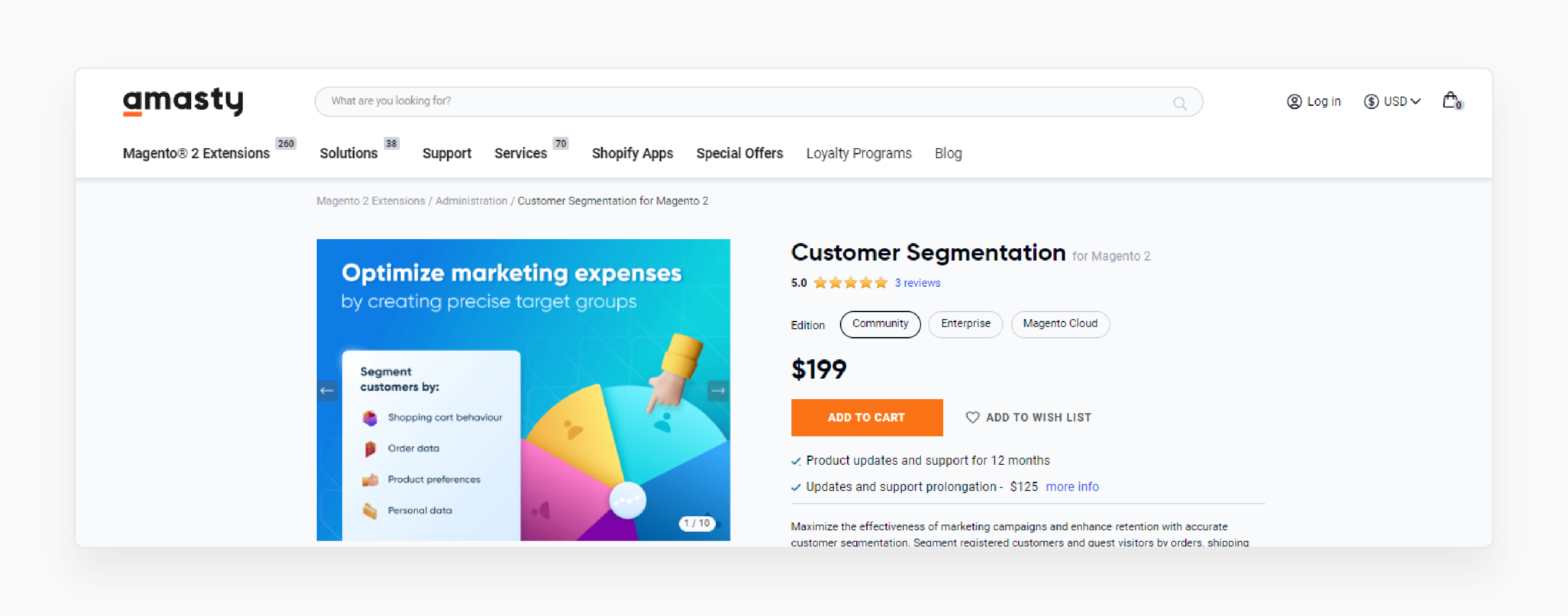
Customer Segmentation extension by Amasty helps personalize marketing efforts. It enables more precise and effective campaigns that boost engagement and conversions. It includes the Amasty affiliate to segment customers.
Key Features: Segments customers based on attributes like purchase history, location, and behavior.
Prices for:
-
Community Edition: $199
-
Enterprise Edition: $499
-
Magento Cloud: $799
Magento Compatibility: 2.4.6-p4; 2.4.5-p6; 2.4.4-p7; 2.3.7-p4
Benefits: Use the extension with Amasty affiliate targeted marketing and personalization. It increases conversion rates and customer engagement.
2. Customer Segmentation Suite for Magento 2 by Mirasvit
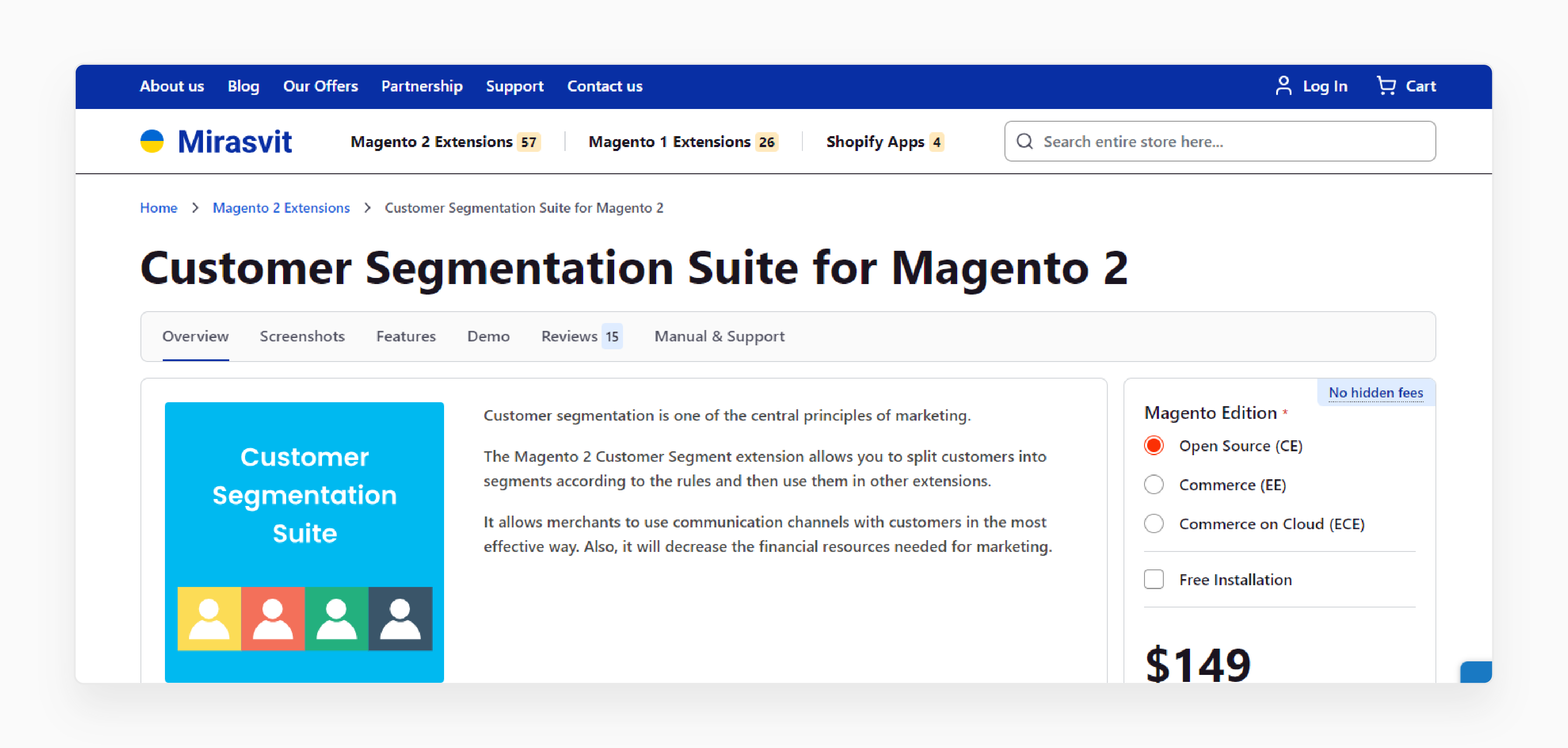
Customer Segmentation Suite by Mirasvit supports dynamic segmentation. It helps businesses deliver highly personalized marketing campaigns. The tool also boosts overall customer engagement and conversions.
Key Features: Advanced segmentation based on multiple criteria with a user-friendly interface. Supports real-time segmentation.
Prices for:
-
Magento Open Source (CE): $149
-
Commerce (EE): $298
-
Commerce on Cloud (ECE): $348
Magento Compatibility: Community and Enterprise- 2.3 - 2.4.7
Benefits: Provides precise marketing strategies with detailed customer insights and real-time data updates.
3. Customer Segmentation Extension for Magento 2 by Aheadwords
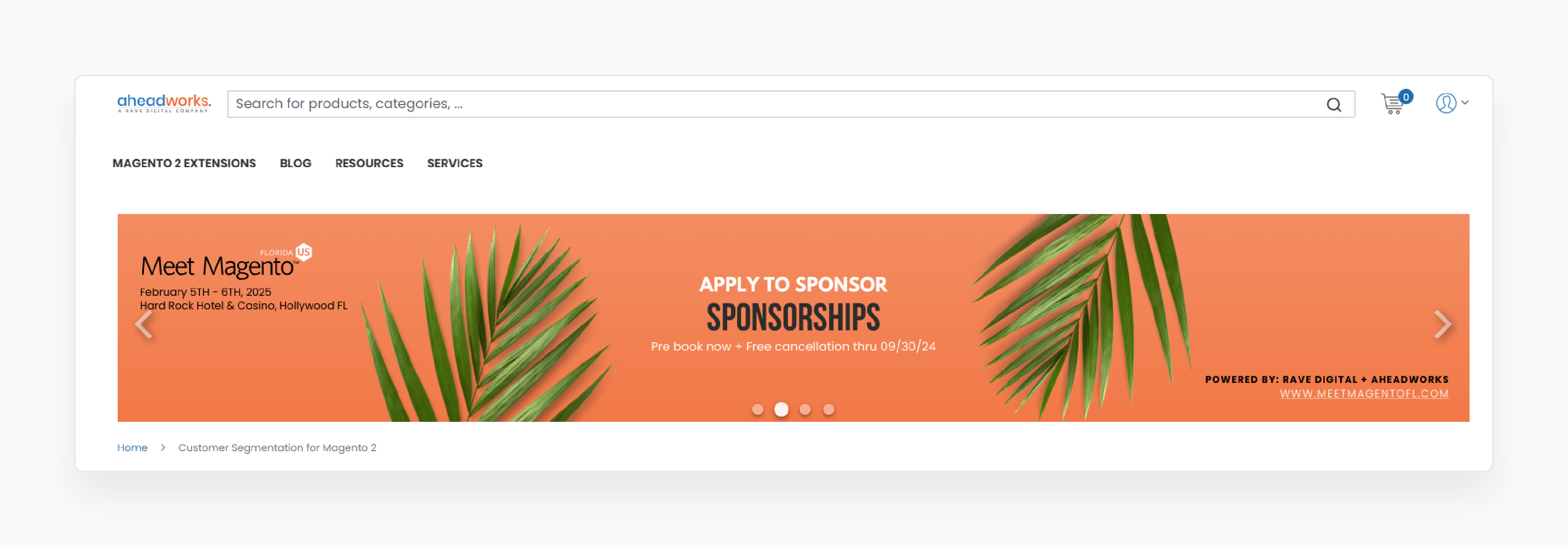
Customer Segmentation extension by Aheadworks empowers merchants to deliver personalized marketing campaigns. It improves customer targeting and increases overall sales effectiveness.
Key Features: Creates dynamic customer segments based on actions and customer preferences. Supports rule-based segmentation and integrates with other products.
Prices for:
-
Open Source- $169
-
Commerce- $ 339
Magento Compatibility: Open Source and commerce- 2.4.6 - 2.4.7
Benefits: Automates segmentation and enables highly targeted marketing efforts with real-time updates.
4. Magento 2 Customer Segmentation by Magezon
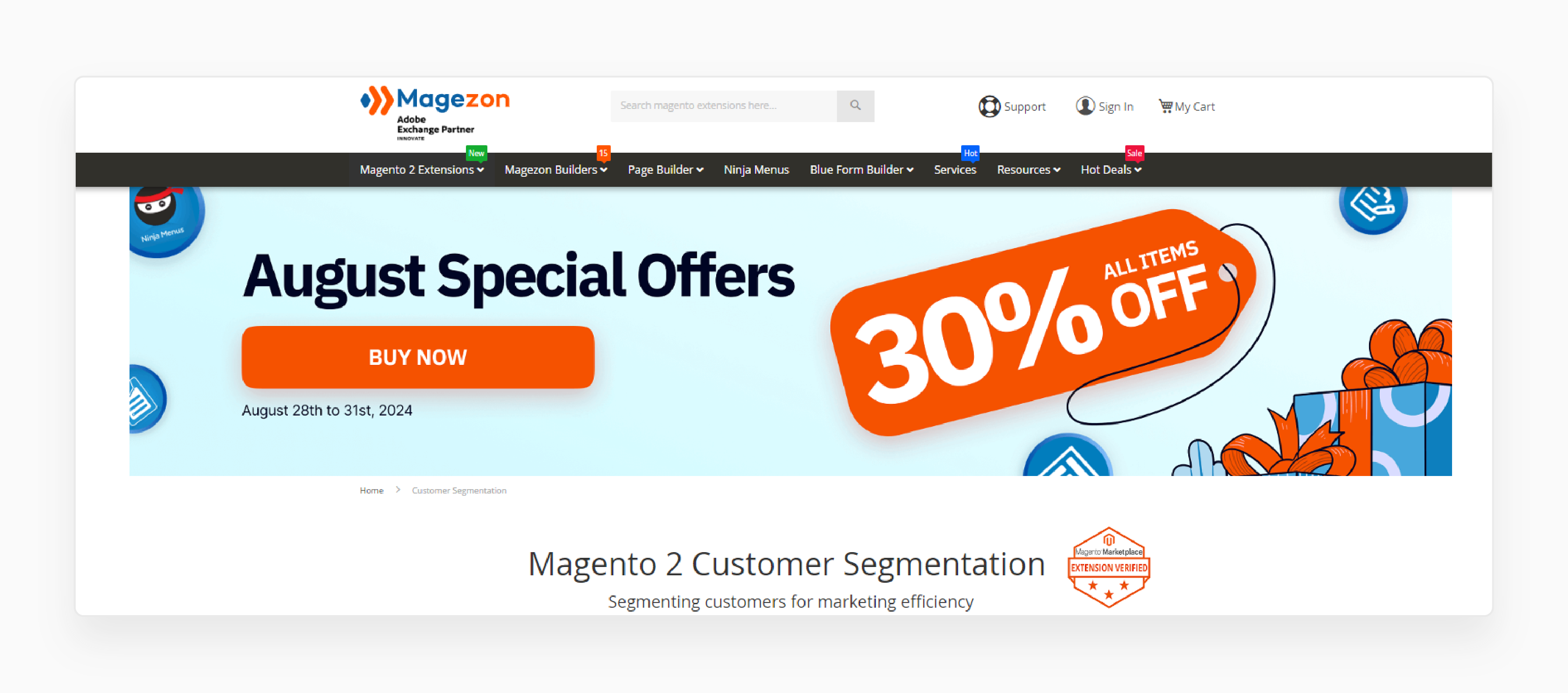
Magento 2 Customer Segmentation by Magezon is fully compatible. It is a comprehensive tool to run marketing campaigns better. It allows store owners to split both registered and guest customers.
Key Features: Manage via the grid and export to CSV/XML. The tool integrates with Cart Price Rules and automates updates every 12 hours.
Prices for:
| Editions/Time | 3 Months | 6 Months | 1 Year |
|---|---|---|---|
| Community | $ 149 | $ 228 | $ 278 |
| Enterprise | $ 349 | $ 428 | $ 478 |
Magento Compatibility: Community and Enterprise- 2.0.x - 2.4.x
Benefits: Enhance and Create accurate customer segments, improve marketing efforts, and boost sales.
5. Magento 2 Customer Segment by Landofcoder
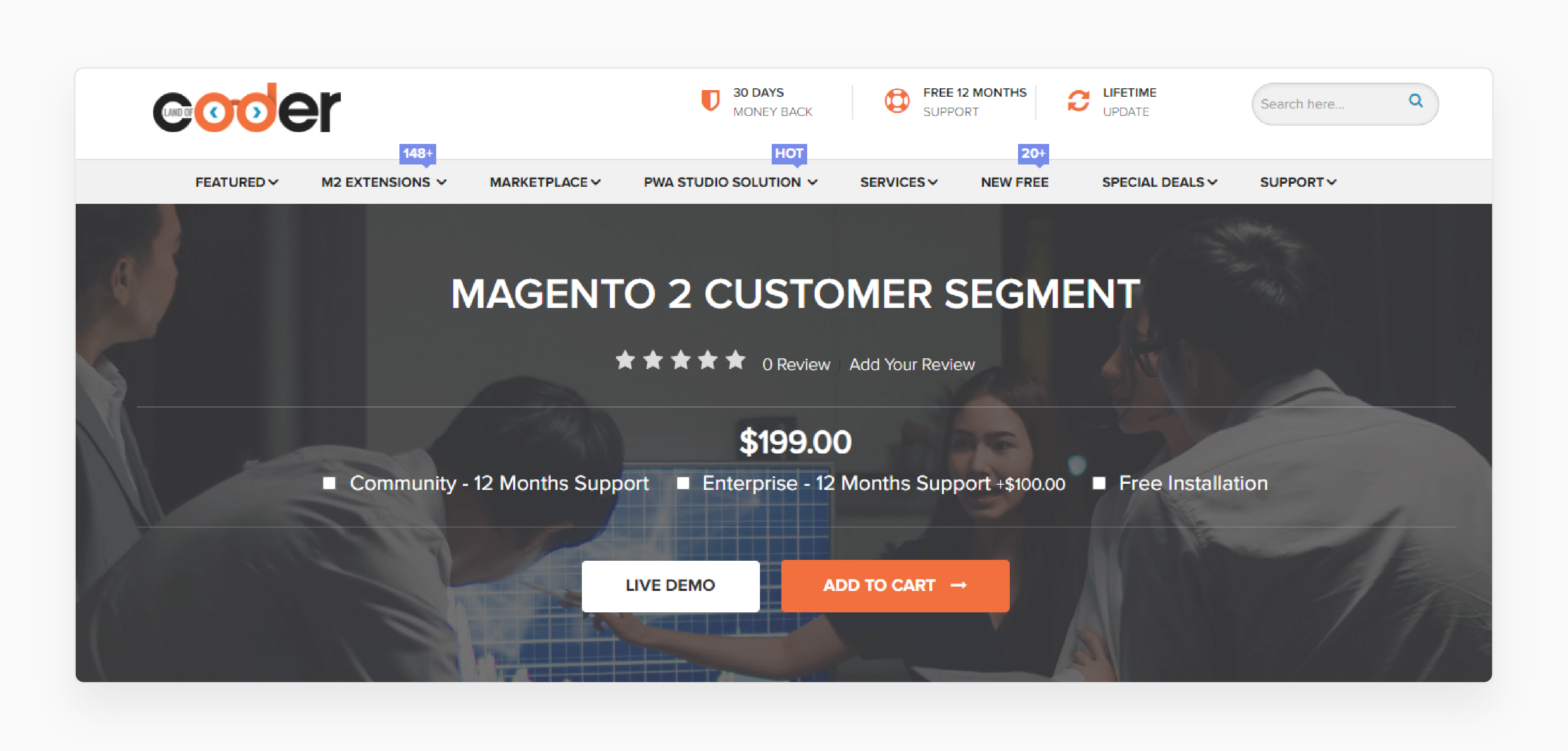
Customer segment extension by Landofcoder provides a flexible way to segment registered customers. It is based on various conditions, including demographics, behavior, and preferences.
Key Features: Segment registered and guest customers, configure sale rules, and automate updates. Export segments to CSV, refresh with cron jobs, and Rest API supported.
Price: Starts at $199
Magento Compatibility: Community and Enterprise - 2.3.x - 2.4.x
Benefits: Organize customer groups, create precise targeted marketing, and improve sales and revenue.
Tips and Tricks of Customer Segmentation in Magento 2
| Tip | Details |
|---|---|
| Start Small | Begin by creating a few segments and gradually add more as you collect more data. The approach helps you manage and refine your segmentation strategy effectively. |
| Use Cart Price Rules | Offer personalized discounts to customers in specific segments by using cart price rules. It encourages conversions and improves customer satisfaction. |
| Use Multiple Attributes | Combine various attributes and conditions, like demographics and purchase history. It creates more targeted and relevant segments for the campaigns. |
| Monitor and Adjust | Regularly check the performance of the segments and make necessary adjustments. It ensures that the segments remain accurate and effective over time. |
| Integrate with Other Extensions | Enhance customer segmentation by integrating Magento marketing tools. It includes follow-up emails and Advanced Reports. The customer segments using a more personalized and effective customer experience for Magento. |
| Apply Segmentation Rules | Use segmentation rules to group both registered and guest customers into specific segments. This allows for more precise targeting in your marketing efforts. |
| Keep Segments Updated | Regularly review and update flexible segmentation rules to arrange registered and current segments. It ensures your marketing efforts stay relevant and effective. |
| Create Targeted Campaigns | Design marketing campaigns directly address the unique needs and interests of each segment. It increases the relevance and impact of your campaigns. |
| Test and Refine | Continuously test and refine the segmentation rules to ensure accuracy and effectiveness. It improves the Magento optimization performance by creating flexible segmentation rules. |
10 Troubleshooting Issues for Customer Segments in Magento 2
-
Failed Segments Indexing: Segments may not update correctly. There could be Magento errors during indexing. It often happens when matching customers without addresses. Ensure customer address attributes are available to set up correctly.
-
Incorrect Segmentation Results: Segments do not include customers if there are incorrect rules. Another reason could be if the data does not match. Review and adjust the Magento segmentation rules to make sure they are accurate. It should be according to the user guide for every customer.
-
Performance Issues: Large Magento databases can slow down e-commerce stores. Simplify the segmentation rules and use Magento’s tools to manage large data sets.
-
Integration Conflicts: Conflicts can happen when using customer segmentation with other Magento extensions. Especially if there’s an error with failed segments indexing. Make sure all extensions are compatible and up to date.
-
Cron Job Failures: If segments are not updating automatically, the cron job might not be set up right. Check the cron jobs to ensure they are refreshing and reindexing segments.
-
Exporting Issues: Problems can occur when exporting segmentation lists. It includes CSV or XML files of the Magento 2 store. Make sure the export settings are correct and the file formats are supported.
-
Magento 2 Personalization Errors: Segments do not show personalized content if not updated. The segmentation rules allow for real-time updates to implement personalization in Magento 2.
-
Data Mismatch: Segments do not match the right customer groups based on outdated data. Update customer data and use flexible rules to account for different customer types.
-
Customer Account Issues: If customer accounts do not show the correct segments. It might be due to errors or mismatched conditions. Review the account details and conditions used for segmenting.
-
User Guide and Support: If issues persist, consult the user guide. It comes with the Magento extension. For further help, contact the extension provider. Use the third-party Magento tools.
FAQs
1. How do I create customer segments based on specific criteria in Magento 2?
Magento 2 lets you create customer segments based on things like:
-
Preferences
-
Purchase history
-
Location
You can use flexible rules to group registered customers and guests. It helps to target your marketing more effectively.
2. Can I segment registered customers and guest visitors separately?
You can create separate segments for registered customers and guest visitors. By grouping them based on their preferences and behaviors. It can deliver more personalized strategies for marketing that fit each segment's needs.
3. What are the benefits of using customer segmentation with Magento extensions?
Using Magento extensions helps you segment customers. It can use custom affiliate links or other criteria. The Magento 2 customer segmentation allows merchants to target specific customer groups.
4. How do I handle failed segment indexing when matching customers without addresses?
If segments do not index correctly, check the customer address details. It might be set up correctly. The extension helps avoid error logs and ensures accurate segmentation.
5. Can I create customer segments based on location in Magento 2?
You can create segments based on location in Magento 2. By using flexible rules and customer address details utilize marketing for specific regions. It makes the campaigns depending on a customer location to enhance ecommerce.
6. Is the Magento 2 customer segmentation extension compatible with other Magento extensions?
The customer segmentation extension is fully compatible with Magento. It allows you to improve your segmentation and personalize your marketing efforts.
7. How can I manage different customer segments in Magento 2?
You can manage different customer segments in Magento 2 by using rules. It helps to group registered customers and guests into specific categories. The extension helps you run targeted campaigns. It is for specific customer based on the segments.
Summary
Magento 2 Customer Segments allows businesses to group customers. It helps to create and run highly targeted marketing campaigns to boost conversions. Consider the following key features:
-
Rule-Based Categorization: Create customer segments with flexible rules for registered customers.
-
Cart Price Integration: Use segmentation with Cart Price Rules for targeted campaigns.
-
Exportable Lists: Export segments in CSV or XML for a better strategy.
-
Performance Tracking: Track segment performance with detailed reports.
-
Data Visualization: Visualize segment data with various chart types.
-
Multi-Store Support: Compatible with multi-store and multi-language setups.
Explore managed Magento hosting to enhance the targeted customer segments for ecommerce.









